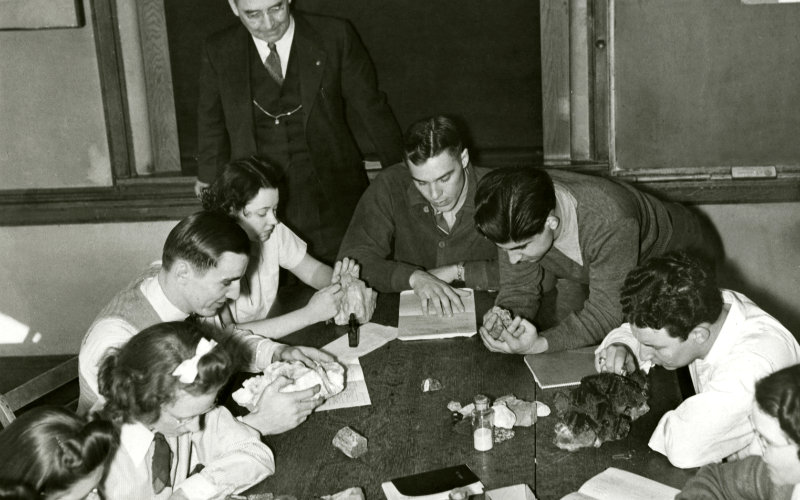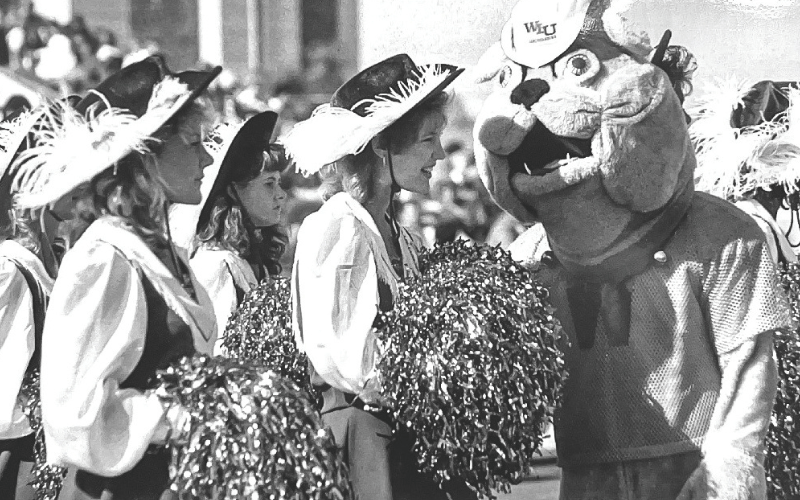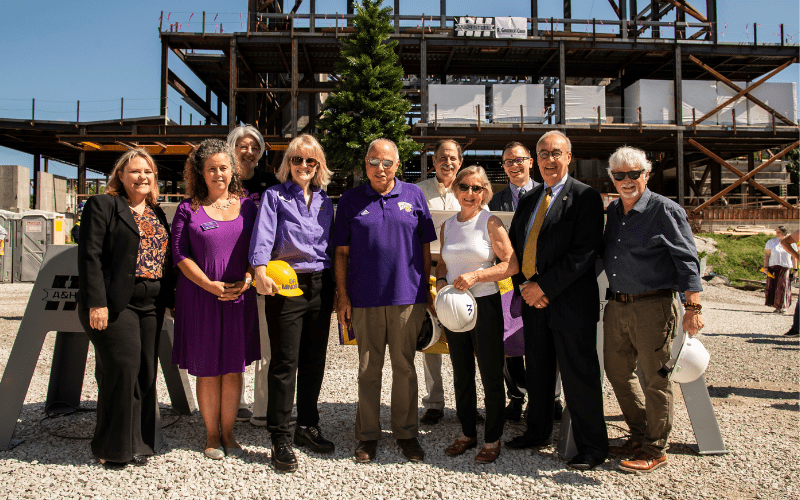

1899
Western Illinois State Normal School is chartered. It was founded as a college devoted to teacher education.

1900
Macomb was chosen as the site for Western Illinois State Normal School. The cornerstone for Sherman Hall was laid on December 21, 1900, at the west edge of Macomb, on Adams Street. Sherman Hall was given its name to honor Illinois legislative leader L.Y. Sherman.

1902
Western officially opens. Approximately 525 students were enrolled in fourteen grades
during the first year.

1903
Western Illinois State Normal School had its first graduating class, consisting of two students.

1905
The first student newspaper, The Clionia, was launched in February 1905. It was a monthly publication that carried essays, as well as announcements and activity reports. In November, its name was changed to the Western Courier. The newspaper involved many students over the years, including famed Black civil rights leader C.T. Vivian in the 1940s, and it continued to appear until 2020.

1906
Alfred Bayliss takes over as President. He served in the 11th Michigan Cavalry during the Civil War. After he was chosen as the Illinois Superintendent of Public Instruction, Bayliss was the leading advocate for another state normal school--especially to provide college-educated teachers for the 11,000 rural schools. So, in a sense, he was the foremost voice for normal schools in Illinois, and behind the scenes, he was Western’s chief founder.

1906
Six Filipinos were registered as students, marking the beginning of international students on campus. WIU also welcomed its first black student, Alonxo Thorpe, who played right end on the 1906 football team.

1911
WIU’s extension program began. Western became the first state institution in Illinois to offer classes by extension.

1912
Walter Morgan is named the new WIU President. Within his first year he secured national accreditation for Western as a teacher’s college. Morgan felt a normal school should also build character, as well as educate, so he vigorously supported Western’s YMCA and YWCA organizations. He also received state appropriations for the first dormitory on campus, named Monroe Hall in honor of President James Monroe. It opened in December 1913, and years later it was renamed Grote Hall to honor faculty member Caroline Grote.

1913
Western received full accreditation as a teachers college by the North Central Association of Colleges and Schools.

1917
A four-year collegiate program was initiated. Western was no longer just focused on educating teachers for the lower grades, although most Western students continued with that purpose.

1918
The first baccalaureate degree was granted. By 1918 Western had fifteen departments, and the new four-year program would lead to a Bachelor of Arts in Education degree, rather than just a normal school diploma. This academic change ultimately led to the establishment of the university 20 years later. The trend toward specialization also led to the establishment of special focus organizations, such as the Home Economics Club, shown in the photograph. The number of student organizations increased significantly in the post-World War I era as well.

1921
On June 3, 1921, the General Assembly changed the name of Western Illinois State Normal School to Western Illinois State Teachers College. There was an enrollment of 518 post-high school students.

1926
Ray Hanson is hired to take over the Physical Education program and football team. An athlete and coach from Minnesota, he had also served in the Marine Corps during World War I. For his heroic action on the front, he received the Navy Cross, the Silver Star, and the Purple Heart. Hanson also received permission from the U.S. Navy to use the “Leathernecks” for his team. WIU still holds the distinction of being the only non-military institution to officially have its nickname derived from an armed forces unit.

1942
Frank A. Beu takes over as President. A sincere, approachable, hard-working man—who was usually on campus before dawn—he was soon admired and liked by both students and faculty. And he established a Western speaker’s bureau, to provide speakers from among the faculty for organizations within the Western Illinois region.

1943
The first fraternities and sororities were authorized and established on campus. The first sororities, Alpha Sigma Alpha and Phi Kappa Sigma, were then organized in 1943. Soon Sigma Sigma Sigma and Alpha Sigma Tau were also established, as well as Sigma Tau Gamma, Phi Sigma Epsilon, and others.

1944
Graduate programs were established. Graduate students could enroll in elementary or secondary school curricula. Those in the latter could choose from seven fields of study.

1946
The first master’s degree is awarded at Western.

1947
Western Illinois Teachers College is renamed Western Illinois State College.

1949
Western marked its 50th anniversary with the 1949 Homecoming celebration. The crowds for that annual event increased — reaching more than 7,000. The huge parade encompassed 70 floats and 20 bands.

1957
The state legislature changed the institution’s name to Western Illinois University. The Teachers College Board authorized a four-year liberal arts and sciences program leading to a bachelor’s degree. Enrollment was 2,605.

1958
Arthur Knoblauch takes over as president. In 1958 President Knoblauch instituted an innovative Division of International Programs which reinforced Western’s commitment to social concern and appreciation across ethnic and cultural lines. Knoblauch was also a committed builder, too, so he received appropriations for two dozen new buildings, which completely re-shaped the campus. New buildings included Western Hall, Lincoln and Washington, Corbin and Olson, Bayliss and Henninger, Browne, Knoblauch, and Memorial.

1964
University Union completed. It featured several places to eat, including the Lincoln Room, a cafeteria known as the Lamoine Room, and a snack shop called The Tract. There were sizable entertainment rooms as well, and the lowest level had recreational facilities. The expanding enrollment led to an addition to the Union in 1968, which included a bookstore and 31 guest rooms.

1968
John T. Bernhard takes over as President. WIU students worked with President Bernhard for long-needed reforms. Those changes included abolishing women’s hours and relaxing the dress code. Many other changes came as well. President Bernhard was an effective voice for the community in a challenging era.

1973
Total enrollment at Western Illinois University reached an all-time high of 15,469.

1974
Leslie Malpass takes over as President. When Malpass arrived WIU had 744 faculty members in six colleges and forty academic departments—providing 50 undergraduate and 33 graduate degree programs. The enrollment was 14,237.

1978
One modern building of major significance for university students, staff, faculty, and administration houses Western’s main library collection. There are also smaller, specialized libraries on campus devoted to music and to teacher education, but the main facility is located on Western Avenue. That library building, completed and dedicated in 1978 at a cost of 12.5-million dollars, represents a major feat of design and engineering. It has a seating capacity of 1,550 and has space for about one million books.

1987
Ralph Wagoner takes over as President. During his six-year presidency, Wagoner struggled to maintain Western’s programs, despite reductions in state funding. But he was committed to Western’s heritage and regional connections.

1988
Western Illinois University’s Rock Island Regional Undergraduate Center (RIRUC) opened on the campus of Black Hawk College in Moline with an enrollment of 59 students. The center was focused on improving communities by providing research and technical assistance, policy evaluation, and educational programming for community leaders and residents.

1993
Donald S. Spencer was selected as Western’s ninth president. He did some reorganizing at Western. For example, three colleges were renamed as departments were transferred to them: the College of Business and Technology, the College of Education and Human Services, and the College of Fine Arts and Communication. He also battled declining enrollment and promoted a wide-ranging emphasis on academic excellence. Also, during his presidency, the State Board of Governors was eliminated, and a WIU Board of Trustees was created.

1994
President Spencer initiated the annual Founder’s Day Celebration, on September 23, 1994.

1995
Western Illinois University purchases and begins renovation of the IBM building in Moline. The Rock Island Regional Undergraduate Center (RIRUC) name is changed to the Western Illinois University Regional Center (WIU-RC).

1997
Western Illinois University began offering classes at its newly renovated Regional Center in Moline.

1999
Western Illinois University celebrated its centennial.

2002
Alvin Goldfarb takes over as President. He supported the creation of Western’s First-Year Experience program and Western’s first doctoral program in education, as well as various new programs in liberal arts and sciences.

2003
Western Illinois University receives a gift of real estate from Deere & Company to create the expanded WIU-Quad Cities Riverfront Campus.

2004
Goldfarb outlined the Western Illinois University strategic plan, which identifies the core values and strengths of WIU. The plan was titled Higher Values in Higher Education: A Plan for Western Illinois University.

2009
The Multicultural Center opens its doors to students. It houses the Casa Latina Cultural Center, the Gwendolyn Brooks Cultural Center (for Blacks) and the Women’s Center.

2010
Western Illinois University breaks ground for the Quad Cities Riverfront Campus.

2011
Jack Thomas takes over as President. Thomas, the first black president for WIU, was an effective voice for Western’s mission.

2012
Grand opening of WIU-Quad Cities Riverfront Campus, a second and third building were opened in 2014.

2019
Martin Abraham becomes Interim President. During his interim presidency, he led Western’s efforts to cope with the coronavirus pandemic — which virtually eliminated in-person class participation and activities.

2020
Guiyou Huang takes over as president. Born and raised in China, he came to America in 1989, earned his doctorate, and became a U.S. Citizen in 1998. At WIU he made efforts to increase enrollment and foster relationships with the community and region.

2021
WIU receives its 10-year reaccreditation from the Higher Learning Commission.

2022
Western Illinois University breaks ground and construction begins for the state-funded Alvin Goldfarb Center for Performing Arts on the Macomb campus.

2024
Kristi Mindrup takes over as Interim President. She is the first woman to ever serve as Western Illinois University’s president.

2024
In WIU’s 125th anniversary year, the most long-sought and well-known recent campus facility is nearing completion, the Goldfarb Center for the Performing Arts. As a report on the construction project recently indicated, “The 130,000-square-foot Performing Arts Center will include a 1,400-seat proscenium theatre and auditorium with two balconies, a 250-seat thrust stage [open to the audience on three sides], theatre, and a 150-seat studio-theatre.” And the facility will house dance, music, and theatre rehearsal studios. The first state-supported building at WIU since the 1970s, it has been the result of a huge effort to secure funding. Aside from its crucial functions for the College of Fine Arts and Communications, as well as the university generally, the new Goldfarb Center for the Performing Arts is intended to have a region-wide cultural impact.

Connect with us: